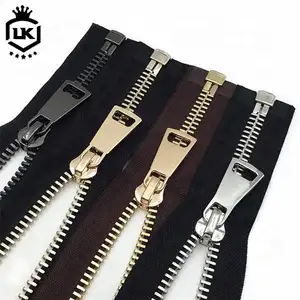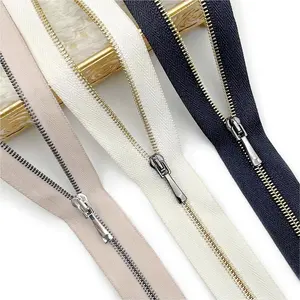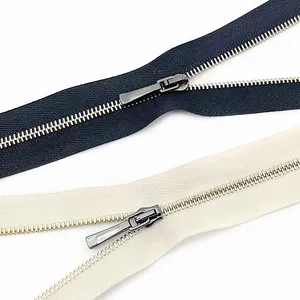
All categories
Featured selections
Trade Assurance
Buyer Central
Help Center
Get the app
Become a supplier

(33501 products available)



















































Designer decorative zippers are available in different styles and types. Each type has unique features and is suited for particular applications. Here are some of their common types:
Metal Zippers
Metal zippers are made of brass, aluminum, or nickel. They are durable and can withstand wear and tear. These designer decorative zippers are suitable for heavy fabrics like denim and leather. They provide a secure closure and add a touch of elegance to garments and bags. Metal zippers can be exposed or hidden, depending on the design requirements.
Plastic or Nylon Zippers
Plastic or nylon zippers feature teeth made of molded plastic or nylon. These zippers are lightweight, flexible, and resistant to corrosion. They are ideal for lightweight and flexible fabrics like cotton, polyester, and nylon. Plastic or nylon zippers are available in various colors and can blend seamlessly with the fabric or stand out as a decorative element. They are suitable for both clothing and accessories.
Coil Zippers
Coil zippers have teeth made of flexible fabric tape with nylon or plastic coils. These zippers are smooth in operation and can be curved or shaped to fit different design requirements. Coil zippers are versatile and suitable for various applications, including garments, bags, and tents. They can be exposed or hidden and are available in different lengths and colors. Coil zippers are known for their reliability and ease of use.
Invisible Zippers
These decorative zippers are hidden within the garment or item. Their teeth are concealed when the zipper is closed. Invisible zippers create a seamless and polished look. They are commonly used in dresses, skirts, and fitted garments. Invisible zippers can also be used in bags and accessories for a clean and unobtrusive closure. They are usually installed with the zipper tape facing inward, making them virtually invisible in the finished product.
Exposed Zippers
Exposed zippers are visible on the outside of the garment or item. They are intentionally left exposed as a design feature. Exposed zippers add a modern and edgy look to clothing and accessories. They can be used as a decorative element, showcasing the zipper teeth and puller as part of the overall design. Exposed zippers are commonly used in jackets, skirts, and bags, where they serve both functional and aesthetic purposes.
Decorative Zippers
These zippers incorporate embellishments such as sequins, beads, embroidery, or appliques. They are designed to enhance the visual appeal of garments and accessories. Decorative zippers are available in various styles and can be used as focal points or accents in a design. They are suitable for evening wear, formal attire, and high fashion accessories, adding a touch of luxury and sophistication.
Separable Zippers
Separable zippers have two sides that separate completely. These zippers are used in garments that open fully, such as jackets, coats, and bags. Separable zippers allow for easy dressing and undressing, providing a practical solution for outerwear and large bags. They are available in various lengths and styles, catering to different design requirements.
Wearing designer decorative zippers can vary widely depending on the item they are adorning. Generally, these zippers are integrated into garments, bags, or accessories as both functional and aesthetic components. For clothing items like jackets, dresses, or pants, they should be worn by pulling the zipper up or down to open or close the garment. Ensure that the fabric is neatly aligned with the zipper teeth to prevent snags or jams. In the case of handbags or wallets, these zippers function similarly. They should be zipped up to secure the contents or unzipped when one needs to access items inside.
When it comes to wearing accessories like hoodies, sweatshirts, or hooded jackets, decorative zippers are often used not just for closure but also as style statements. They can be left partially zipped for a casual, laid-back look, or fully zipped for a more sleek and streamlined appearance. Always pay attention to the fit of the garment around the zipper area; it should be comfortable and not too tight to allow for easy movement without compromising the overall aesthetic appeal of the designer piece one is wearing.
Matching decorative zippers requires consideration of both functionality and aesthetic appeal. When one is selecting a zipper for a specific garment or accessory, they should consider the style and purpose of the item. For instance, chunky metal zippers can add a rugged, industrial vibe to jackets or bags, while delicate, hidden zippers are ideal for creating a clean, seamless look in dresses or tailored pants. The finish of the zipper is also important; gold or silver tones can lend a touch of luxury, whereas a matte finish might suit a more casual or understated design.
Color coordination is another key factor in matching decorative zippers. Ideally, the zipper should complement or contrast harmoniously with the fabric of the garment. A contrasting color can create a bold statement, whereas a zipper that closely matches the fabric can offer a subtle, elegant detail. Additionally, one should pay attention to the overall color palette of the outfit. They should ensure that the zipper's hue aligns with other elements to achieve a cohesive look. Lastly, consider the weight and texture of the fabric when choosing a zipper. Lighter zippers work better with delicate fabrics, while heavier zippers are suitable for sturdy materials like denim or leather.
Q1: What materials are commonly used for decorative designer zippers?
A1: Decorative designer zippers are crafted from a variety of materials. These include metal, plastic, nylon, and unique fabrics like leather or suede. The choice of material depends on the desired aesthetic and functionality.
Q2: Can decorative zippers be used for both clothing and accessories?
A2: Yes, decorative zippers are versatile. They can be used for clothing items like jackets, dresses, and skirts. They can also be used for accessories such as bags and pouches.
Q3: Are decorative zippers available in custom designs?
A3: Yes, many suppliers on platforms like Alibaba.com offer customization options. This allows for the creation of unique patterns, logos, and branding on decorative zippers.
Q4: What are some popular uses for decorative zippers?
A4: Decorative zippers are commonly used in clothing items such as jackets, dresses, and skirts. They are also used in bags, purses, and other accessories to add functionality and visual interest.
Q5: How can one ensure the quality of decorative zippers?
A5: To ensure quality, it's important to source decorative zippers from reputable suppliers. One can request samples before placing a larger order to assess the zipper's functionality and durability.